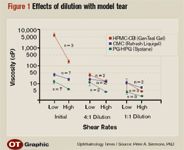Article
Mid-viscosity artificial tear provides comfort, relief
Fort Lauderdale, FL-Results from a series of in vitro experiments designed to predict on-eye viscosity show that the mid-viscosity artificial tear product Refresh Liquigel (Allergan) offers a favorable profile that would be expected to translate into excellent comfort and relief from dry eye symptoms with minimal undesired visual effects, said Peter A. Simmons, PhD, at the annual meeting of the Association for Research in Vision and Ophthalmology.
Fort Lauderdale, FL-Results from a series of in vitro experiments designed to predict on-eye viscosity show that the mid-viscosity artificial tear product Refresh Liquigel (Allergan) offers a favorable profile that would be expected to translate into excellent comfort and relief from dry eye symptoms with minimal undesired visual effects, said Peter A. Simmons, PhD, at the annual meeting of the Association for Research in Vision and Ophthalmology.
Dr. Simmons, senior clinical research scientist, Eye Care Re- search and Development, Allergan, Irvine, CA, tested the viscosity of Refresh Liquigel and two other mid-viscosity artificial tear products in models that reflected conditions in their original package and on the ocular surface. The latter tests were performed by adjusting temperature and pH, mixing the products with different proportions of a model tear solution to reproduce dilutions achieved immediately upon instillation and after several minutes, and at different shear rates to judge how viscosity changes as the lids sweep over the eye during blinking.

"With their differences in polymers and other ingredients, different artificial tear products vary in how their viscosity changes in response to the changing conditions they encounter on the ocular surface. These studies reinforce the importance of knowing what the viscosity of a product is like-not in its container, but as it reaches the warmer ocular surface, mixes with tear fluid, and is exposed to the shear forces of the closing lid," he explained.

Dr. Simmons explained that viscosity of topical ocular products cannot be accurately measured in situ. However, because instillation of an artificial tear product on the eye results in physical changes that can affect viscosity, it is necessary to create artificial test conditions that simulate the ocular surface.
Newsletter
Don’t miss out—get Ophthalmology Times updates on the latest clinical advancements and expert interviews, straight to your inbox.




